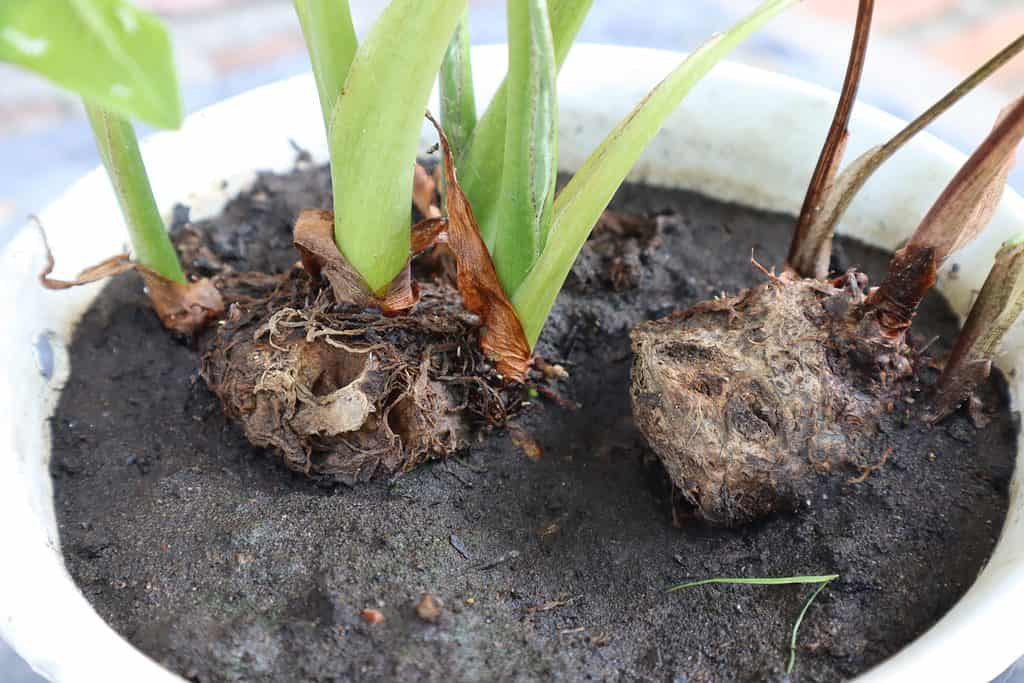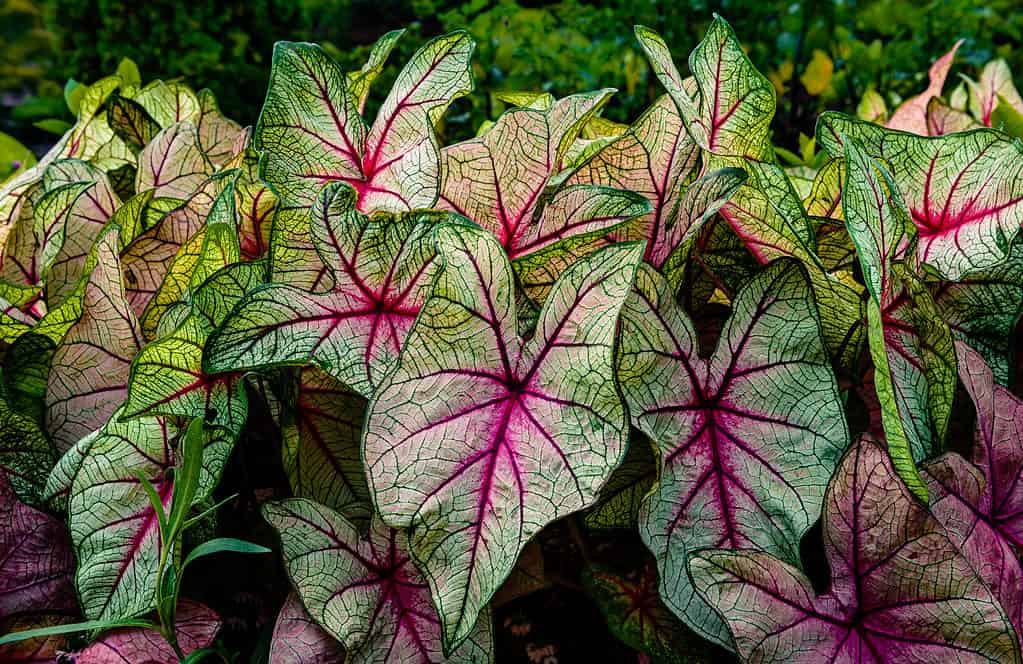When you think of the spring garden, you probably think of elegant, showy flower blossoms in all shades of the rainbow. You may not be very familiar, then, with caladiums. These warm-tempered tubers are also planted in the spring, but they are primarily grown for their impactful and colorful foliage rather than for their blooms.
While your other flowers are soaking up the sun, caladiums can lend interest and summer color to the shady, harder-to-fill areas of your yard as well as to the brighter rooms of your home.
| Botanical Name | Caladium bicolor, Caladium sp. |
| Popular Options | Thousands of cultivars. Fancy-leafed and narrow-leafed varieties. E.g. Caladium bicolor ‘New Wave’; Caladium bicolor ‘Allure’; Caladium bicolor ‘Pink Beauty’ |
| Sunlight | Light, dappled sunlight to full shade |
| Water | Keep soil moist throughout the growing season |
| Soil | Well-draining, and rich in organic matter. Mulch to aid in moisture retention. |
| Hardiness | Perennial only in USDA Zones 9-11. Grown as annual in Zones 8 and below. |
| For Beginners? | Yes, beginner friendly. Very simple to care for. |
What Is a Caladium Bulb?
Caladium, often referred to as elephant ear, is a genus of tropical plants that is native across Central and South America. It is a part of the arum family, Araceae, which it shares with the philodendrons, anthuriums, and monsteras.
In its native forests, the caladium grows as a perennial. It sends up its new foliage for the year in the spring and summer when water is plentiful and persists until the dry season begins. When the soil begins to dry out, it allows its leaves to wilt away and retreats underground where it remains dormant until the next rainy season.
To make it through its dormancy and produce new foliage in the spring, the caladium relies on the starchy nutrients that it produces throughout the growing season. These nutrients are stored in the plant’s tuber, which many gardeners mistakenly refer to as a bulb.
Bulbs and tubers, while similar in function, differ in structure. Bulbs are made up of many layers of modified, fleshy leaves that surround the embryonic stage of a plant’s future foliage. On the other hand, a tuber is an underground stem all its own, albeit a swollen one. It contains all of the parts of an above-ground stem and produces its growth for the year from its many “eyes”. For a great visual example of the difference between these two storage structures, compare an onion – a true bulb – to a potato, which is a true tuber.

To make it through its dormancy and produce new foliage in the spring,
Caladiumrelies on the nutrients stored in the plant’s tuber.
©Rayhandi/Shutterstock.com
Caladium Groupings
If you’re new to growing caladiums, it will be helpful to know that there are two main groups of cultivars to choose from: the fancy-leafed and the narrow-, or lance-leafed caladiums.
Fancy-Leafed Caladiums
The fancy-leafed varieties produce broad, heart-shaped leaves on tall petioles that can reach heights of up to 30 inches. Tubers of this variety tend to bear fewer leaves than those that are narrow-leafed. Their larger size can be utilized to create accents and focal points among other shade plants in the garden, even other caladiums. They can make an eye-catching statement as well when planted singly.
Lance-Leafed Caladiums
Lance-leafed caladiums, producing a multitude of ruffled, narrow leaves per tuber, are often grown in mass to fill up beds with striking colors and patterns. They are also usually planted along borders, in hanging baskets and porch planters, or in small groups in the shade garden to break up textures and add contrast.
Caladium Bulbs for the Garden
The most common species of Caladium in cultivation is a Brazilian native, Caladium bicolor, and like many spring flower bulbs, it has been bred to produce thousands of recognized cultivars. Each cultivar produces unique and stunningly variegated foliage in shades of red, pink, purple, and green. Many are also white.
If you are interested in planting caladiums alongside your usual spring flowers this year, you may want to consider these decorative and dramatic cultivars for your garden.

The most common species of
Caladiumin cultivation is
Caladium bicolor.
©iStock.com/Vera Shestak
Caladium bicolor ‘New Wave’
Stealing the show with its leaves of red, burnt orange, and gold, this lime green veined Caladium cultivar is sure to catch attention wherever it is planted. Reaching mature heights of 16-24 inches, plant this cultivar as an accent piece or add tropical warmth to your indoor spaces.
Caladium bicolor ‘Pink Gem’
This small variety of Caladium boasts dense, bright, salmon-colored foliage with margins of deep green. They tend to mature on the smaller side, growing only to about 12-18 inches in both height and width. They are perfect candidates for placement in hanging baskets or porch planters.
Caladium bicolor ‘Allure’
Offering up stark white, heart-shaped leaves with dark green veining, this cultivar is an eye-catcher. To complement its showy, contrasting color scheme, this Caladium bears its foliage atop elegantly tall petioles.
Caring for Your Caladiums
Caladium “bulbs” are incredibly easy to care for, provided that you pay careful attention to their specific lighting and watering needs. Follow these basic care instructions and your caladiums will happily take up new residence in your garden.
Planting
When choosing where to plant your caladiums, bear in mind that all parts of the plant are poisonous to humans and pets. Although very rare, ingestion by pets or livestock in large enough amounts can be fatal.
If planting outdoors in the garden bed, you should wait until your soil temperature has risen to 70 degrees Fahrenheit or higher. Caladium tubers are susceptible to rot if planted in soil that is too cold. It can even stunt their growth.
When planted in containers, indoors or out, make certain that your chosen vessel has holes for drainage. Caladiums are especially sensitive to moisture.
Like plant bulbs and corms, your Caladium tubers need to be oriented properly in the soil to grow. They should be planted with their buds, or eyes, facing upward.
Sunlight
Regardless of the Caladium variety you have chosen to plant, sunlight is one of the most important factors to manage. The leaves of these plants are especially sensitive to harsh, direct sunlight and are easily scorched when left exposed. When choosing a location for your plants, whether indoors or outdoors, be sure to choose a tucked-away area that experiences, at most, only dappled or indirect sunlight.
Water
Hailing from tropical forests, these plants need frequent watering. Soil should be kept moist throughout the growing season, which will be made easier by the lack of direct sunlight. Do not completely saturate the soil, however, and avoid standing water at all costs. Caladiums are not only sensitive to sunlight but also excess moisture, and rot quickly in overly wet conditions.
Soil Conditions
The ideal soil for caladiums holds moisture evenly, is well-draining, and is slightly acidic. If soil is too heavy and forms puddles, it should be carefully amended to increase the amount of organic matter. Higher content of organic matter such as compost or well-rotted manure helps both drainage and moisture retention, as well as oxygenation. It also aids in the uptake of nutrients.

When choosing a location for your
Caladium, whether indoors or outdoors, ensure it receives only dappled or indirect sunlight.
©iStock.com/Licec
End-of-Season Care
Even under the best growing conditions, your caladiums eventually need to rest. As the growing season draws to a close, you may wish to take additional steps to help your plants grow again in the following year.
Propagation
Like potatoes, caladium tubers can be propagated by cutting them into pieces. As long as each new piece contains one or more eyes, they should be able to form new plants in the next season. Once cut, allow your new seed tubers to cure and heal over for about 10 days. This curing process seals off the sensitive, internal tissues of the tuber. This will prevent invasion by pathogens and other soil microbes.
Storage
Caladium tubers can be dug up and stored with last season’s flower bulbs. Many gardeners choose not to do so. In USDA Zones 8 or cooler, they are often grown only as annuals and are allowed to die completely with the onset of winter. In Zones 9-11, tubers will simply overwinter and can be left in the ground.
If you would like to store your plants’ tubers so that you can replant them in the spring, they should be carefully and gently dug up once most of their leaves have turned yellow. Leaves should be left attached to the tubers, which should be brushed clean of larger clumps of soil. Allow the tubers and attached foliage to dry out over two weeks. Once dry, leaves can be removed.
Store dried caladium tubers in much the same way as other flower bulbs and corms. Carefully place them in a dry, breathable container, and prevent them from touching one another to prevent potential rot. This container should then be placed in a warm closet or pantry inside your home. Caladiums are tropical plants and die in cold temperatures. Keep storage areas above 65 degrees Fahrenheit all winter long.
The photo featured at the top of this post is © The na/Shutterstock.com
Sources
- NC State Extension, Available here: https://content.ces.ncsu.edu/caladiums-for-the-home-landscape
- NC State Extension, Available here: https://plants.ces.ncsu.edu/plants/caladium
- LSU Ag Center, Available here: https://www.lsuagcenter.com/profiles/rbogren/articles/page1601586530368
- Clemson Cooperative Extension Home & Garden Information Center, Available here: https://hgic.clemson.edu/factsheet/caladium
- Wisconsin Horticulture, Available here: https://hort.extension.wisc.edu/articles/caladiums
- Missouri Botanical Garden, Available here: https://www.missouribotanicalgarden.org/PlantFinder/PlantFinderDetails.aspx?kempercode=a438
- North Dakota State University, Available here: https://www.ndsu.edu/pubweb/chiwonlee/plsc368/student/papers06/carina%20de%20luca/carinadeluca.htm
Thank you for reading! Have some feedback for us? Contact the AZ Animals editorial team.






